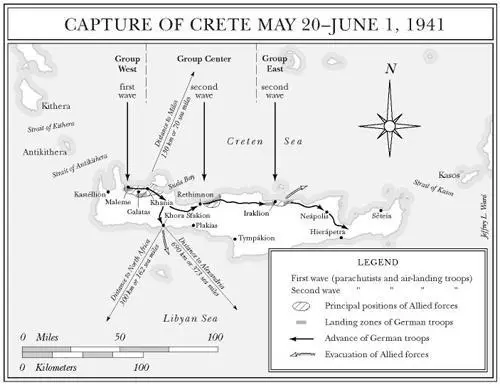Germans who dropped south of Khania could not take the town or Suda Bay and had to go over to the defensive that night. Only in the narrow Tavronitis River valley just west of Maleme were units able to assemble and attack the dominating heights south of the Maleme airport. The New Zealanders emplaced on these heights held off the Germans and kept them from grabbing the airport.

During the night, however, the local New Zealand commander got the false impression that his men were so weakened they couldn’t hold off the enemy. With approval of his brigade commander, he pulled them east a mile or so. This permitted the Germans to move forward and seize a piece of the airfield, plus the heights south of Maleme. This opened part of the field to German aircraft, though it remained within range of British artillery and infantry weapons.
The troops of Group West lost radio contact with headquarters in Greece for a time. Air crews returning to pick up troops for the second wave had not seen what had happened, and thought things had gone well. Consequently, when the bad news began to come in sometime later, it was too late to change plans. Also, delays in refueling aircraft and the poor condition of Greek runways slowed departure of the second wave, while Richthofen’s bombers and fighters had gone ahead to bomb and strafe Rethimnon and Iraklion. By the time the second-wave transports arrived, they were often without protection.
Consequently, the losses at Rethimnon and Iraklion were even higher than in the morning attack. About half the paratroopers were killed as they descended or in the first fights on the ground. The Germans could capture neither town nor local airfields, and survivors, in small isolated detachments, had to go over to the defensive.
Generals Löhr and Student decided the only thing to do was to reinforce the little success they had achieved, at Maleme airfield. On the morning of May 21, some transports landed at a strip of the airport in German hands and delivered urgently needed weapons and munitions. That afternoon several companies of paratroops jumped into this area as well.
With the newly arrived paratroops and their own men, Group West finally cleared the airfield. In the late afternoon, the first 5th Mountain Division troops landed in transports. Even so, they suffered losses, because British guns continued to fire onto the field. By that evening (May 21) eighty destroyed or severely damaged aircraft lay on the airfield.
The Germans around the airport tried to move east in hopes of joining their other units. But the 5th New Zealand Brigade stopped them at Pirgos, a few hundred yards away.
General Freyberg had made a grave tactical error in the first two days. He thought the main German attack was going to come by sea, and refused to move his forces out of their coastal positions at Khania and Suda Bay to shift over and wipe out the Germans around Maleme.
The Germans had in fact planned to send in heavy weapons, equipment, and a few 5th Mountain Division soldiers on May 21 in twenty-five Greek caiques, or small motorized sailing vessels, escorted by an Italian destroyer. But British warships caught the flotilla north of Crete, sank most of the caiques with nearly all the weapons and equipment, along with 300 mountain troops, and sent the remaining vessels flying for the island of Milos to the north.
An even larger group of caiques tried to reach the island on May 22, but Royal Navy ships met them twenty miles south of Milos. This flotilla escaped the fate of the other because an Italian warship bravely shielded the vessels, while Richthofen’s aircraft attacked so hard that the British ships had to turn southwest into the Kithera Strait.
Now commenced the first great air-sea battle of the Second World War. Richthofen’s Stukas were the major killers, giving the first strong lesson in the effectiveness of dive-bombers against naval vessels. In the battles around Crete, the British lost three cruisers and six destroyers, while thirteen other ships were badly damaged, including two battleships and the only aircraft carrier then in the Mediterranean fleet.
The fleet commander, Admiral Sir Andrew Cunningham, pulled most of his ships back to Alexandria on May 23, and began sending fast supply ships to Crete at night to avoid Luftwaffe attacks.
General Freyberg meanwhile had realized his error, and ordered the 5th New Zealand Brigade to win back the Maleme airfield. The attack got under way early on May 22. The New Zealanders almost reached the Tavronitis River on the south, advancing to the eastern edge of the airfield along the coast. At daylight, however, the Luftwaffe moved in to attack and forced them back east of Pirgos. A day later, threatened by a German encircling movement, the New Zealanders withdrew to Galatas. This permitted General Julius Ringel, new commander of Group West, to join forces with isolated parachutists southwest of Khania. Now the Maleme airfield no longer was in range of British artillery. The remainder of the 5th Mountain Division troops arrived, while supply craft came in steadily, transforming the tactical situation.
General Löhr directed Ringel to capture Suda Bay and break the British line of supply, and after that to relieve the parachute units still isolated and pinned down at Rethimnon and Iraklion. Ringel ordered his airborne troops to drive straight eastward on the main road, where they ran up against a solid New Zealand defense at Galatas. It took unrelenting Luftwaffe attacks to break the line and permit the Germans to reach Khania on May 27.
Freyberg informed Wavell that his troops had reached the end of their endurance. On May 27, Churchill and Wavell gave permission and he began to withdraw his force southward twenty-three miles to Khora Sfakion on the south coast and evacuate from there.
On May 28 the Germans broke through bitterly defended rear-guard positions east of Khania and occupied Suda Bay. Meanwhile Freyberg’s main body was moving over a poor track to the south coast. It entirely escaped General Ringel that most of the enemy were heading south, and he sent only a small regiment down the Khora Sfakion road. He directed his main body eastward, which relieved the decimated German units holding out around Rethimnon on May 29 and forced the surrender of an Australian battalion east of the town the next day. The Aussies had not received orders to evacuate until too late. However, entirely unnoticed by the Germans, the British brigade and some Greeks, about 3,500 men, got out on British warships at Iraklion on the night of May 28–29.
The Royal Navy rescued 13,000 soldiers at Khora Sfakion over four nights. The evacuation was a hard, difficult, and dangerous job for the sailors, under constant attack by Luftwaffe aircraft. One of Admiral Cunningham’s staff officers pointed out that the navy had already suffered heavily and wondered whether it should risk more losses.
Cunningham replied: “It takes the navy three years to build a ship, but three hundred years to build a tradition; we must not let the army down.”
General Wavell ended the evacuation on June 1 when he learned that the remaining soldiers no longer had the strength to hold off the German mountain troops who were pressing hard against the port. The 9,000 British soldiers and 1,000 Greeks left behind surrendered.
Looked at objectively, the Cretan operation was a disaster all around. The British lost about 12,000 soldiers on Crete, while navy dead exceeded 2,000. Material losses were enormous. Only about 2,000 Greeks got off the island, and many of the survivors who remained died in guerrilla operations, massacred wherever found, along with numbers of Cretan civilians.
Читать дальше



![Джонатан Димблби - Barbarossa - How Hitler Lost the War [calibre]](/books/385421/dzhonatan-dimblbi-barbarossa-how-hitler-lost-the-w-thumb.webp)









